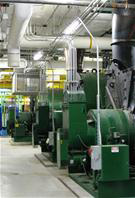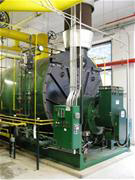
This project was commissioned to help NKCH reduce energy waste and to slow the growth of energy consumption. For each initiative, the return on investment (ROI) and net present value (NPV) was calculated for a 15 year period, using a five percent opportunity cost of money and ASHRAE tables for useful life.
Initiative number one was the AHU CO2 monitoring. The viability of using CO2 controls to reduce the fresh air ventilation for the hospital buildings was examined. Field testing showed that existing NKCH AHU systems provided very conservative levels of ventilation. Ventilation rates can be reduced significantly and still provide sufficient ventilation for the building occupants.
The next initiative was to install revolving doors. This replaced existing sliding doors at the Pavilion first and second floor entrances with revolving doors to reduce fresh air infiltration. Field observations showed that the existing pavilion sliding doors are open more than 50 percent of the time. This causes the building to lose pressure control each day, and lose temperature control during high south winds.
Boiler House heat recovery: blow down heat recovery systems easily provide a financial payback, but limited space prevented the exhaust heat recovery system from being a viable alternative. The first part of this initiative provided boiler stack economizers on four boilers. The second part of this initiative provided a single boiler blowdown heat recovery unit for the existing boilers.
The boiler plant electric boiler initiative evaluated the payback of replacing an existing natural gas boiler with an electric boiler. With recent high natural gas prices, electric boilers provide a  competitive alternative for steam generation. In addition to financial incentives, electric boilers will also provide NKCH with a third energy alternative for generating steam. The base initiative installs and electrode boiler to replace one of its natural gas boilers. As an alternative, NCKH can install the boilers in a 1000 SF addition to the boiler room.
competitive alternative for steam generation. In addition to financial incentives, electric boilers will also provide NKCH with a third energy alternative for generating steam. The base initiative installs and electrode boiler to replace one of its natural gas boilers. As an alternative, NCKH can install the boilers in a 1000 SF addition to the boiler room.
Annual commissioning will reduce operating costs and assure that HVAC systems and associated controls are operating correctly and efficiently. NKCH should focus one facilities staff person on commissioning as their primary job. If insufficient internal resources exist for this to occur, NKCH should expand its staff to complete these tasks.
Alternatives to an AHU economizer evaluates the use of air-cooled chillers for cooling when outdoor air temperatures are 35 – 59 *F, in lieu of using economizer cycles, which require steam humidification.
Finally, new chiller plant controls connect the Main Hospital’s 3rd and 12th floor chiller plants, improving chiller plant operations.